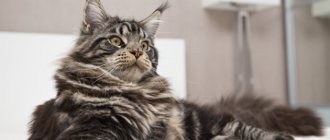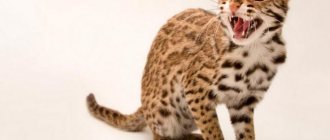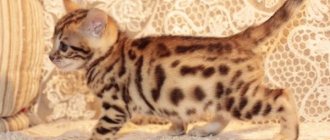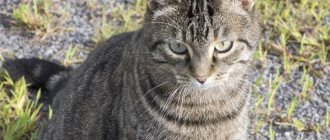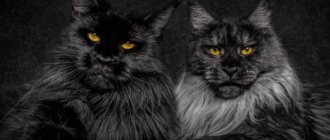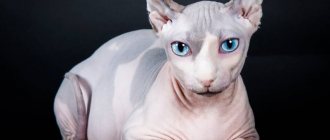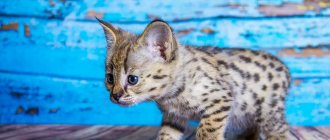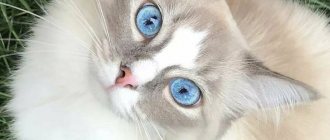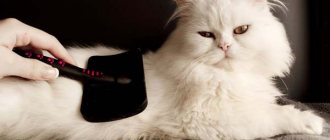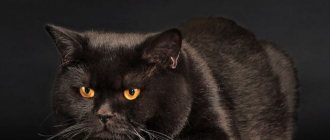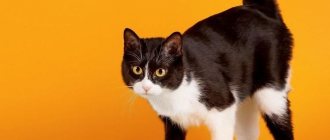History of the York Chocolate cat breed
It all started with Janet Chifari's decision to create her own breed of chocolate cats after discovering a cute, fluffy light brown kitten in her cat's litter.
About 30 years ago, on a farm in New York state, about 9 mongrel and half-pedigreed cats, which, of course, are necessary in any farm, honestly served their purpose.
A couple of half-quarter-something Siamese, one of whom was a pure black cat and the other a spotted white and black cat, had babies. They are as variegated in color and genes as their own parents.
It is impossible not to note the fact that cats living “freely” during the rut will allow any cat who was able to achieve her favor to approach them, therefore, there is no way to claim that the father of the fluffy caramel was this particular coal “chimney sweep” .
More or less worthy of attention is the fact that the cat had long, thin hair, the same hair was awarded to a light brown girl, with whom, it is believed, the new breed, the Yorkie Chocolate, began. More precisely, the breed initially originated in the head of Janet, who set about implementing her plan.
Janet Chifari was never a breeding guru, she did not receive any education in this area, and she had a very weak idea about selective selection and gene compatibility. The owner of the pet didn’t even realize that the Siamese gene played a joke on the cat’s color; she just liked the unusual color. So the York chocolate cat breed was not created by a professional! And soon we will see what came of it.
Subtleties of care
You need to care for a cat with a chocolate color in the same way as for its relative of any other color. In this situation, more attention should be paid to the breed of the cat, but not to the color.
Persian cats must be cared for in the manner required by the breed - combing them thoroughly and often, keeping their faces, teeth and ears clean. Persians need a slicker brush as they are a very fluffy breed.
If a cat likes to walk, she needs to at least wash her paws after walks, and if her hair is long, then she needs to bathe her. Therefore, it is the owner’s job to ensure that the pet gets accustomed to water and is not afraid of it.
A representative of any breed must be taken to a veterinarian for a preventive examination every 6 months. Of course, vaccinations and anti-parasitic measures must be carried out according to schedule.
If your pet is inactive, take care of proper, balanced nutrition. The same applies to castrated males - to avoid obesity, the cat must be fed properly. In general, feeding should be done in strict accordance with the recommendations for the breed.
There are few cats that like to be left alone for long periods of time. Most of them need company or at least the presence of their owner. Leaving them alone for a long time, the owner risks, at a minimum, returning to chaos, and at maximum, the cat will “punish” him, causing a real commotion upon his return. After all, we should not forget that most cats are very capricious, even obstinate, and know how to take offense and take revenge. You should not offend your pet once you have one.
You can take a closer look at the chocolate fold kittens in the next video.
Yorkie cat from Chifari
Kitty Brownie (that’s what Janet called the kitten) was “preserved” until better times and the newly-minted breeder Chifari began to wait for the repetition of the desired color scheme in subsequent kittens. About a year later, she was lucky: the same couple gave birth to a kitten with the same caramel color. He was assigned the role of becoming the main stud cat paired with Brownie.
By the age of one and a half, Brownie herself had acquired the beautiful shape of something between a Siamese and a British cat, and her fur began to darken, “moving” more and more towards dark chocolate.
According to other sources, the chocolate cat was not Brownie's brother, but the son of Brownie herself, but now this no longer matters.
The main thing is that in 1985, Janet was finally able to begin breeding a new breed under the working name “Chocolate Chifari from New York.”
The resulting “pilot group” pleased the breeder - all 6 kittens had the caramel skin and round heads of the old-type Siamese.
Less than 5 years had passed, and the new nursery “Chifari from New York” already had 27 chocolate kittens of an unrecognized breed, and more than 70 of the same chocolates were distributed among relatives and friends.
Brown fluffy kittens with truly Thai manners quickly won places in the hearts of those who acquired them.
Even a unique brand “from Chifari” appeared, and outside the state, such cats began to be called “York cats from Chifari” or “York chocolate cats.”
Kitty
For now, Russian cat breeders can only dream about a chocolate Yorkie cat . A high-quality kitten can be brought from America or Europe. If you find yourself there and decide to buy a chocolate friend, pay attention to the following points:
- Kittens' fur is lighter than that of an adult cat. There may be spots and streaks. This is fine.
- Study the veterinary passport; there should be notes on the animal’s vaccination.
- The baby's eyes, ears, and butt should be clean and free of discharge.
- Familiarize yourself with the rules for importing and exporting animals from the country.
Kittens are inquisitive, playful and active . They poke their curious noses everywhere, so you definitely won’t be bored.
Breed adoption
In 1991, Janet Chifari risked submitting her best cats to the judgment of felinologists. Whether the York Chocolate cat would be adopted or not, Janet did not risk anything particularly: this was a rare case when the popularity of the brand had already outstripped reasonable arguments.
This year they turned Janet down, making it clear that no one was going to consider a cross between a Bombay and a British or a Nibelung with a Siamese as a separate breed, but Jen turned out to be a persistent lady.
It took her two more years to consolidate her position of popularity and distribute a couple dozen more of her chocolate Yorkies across the country.
As they would say “under public pressure”, in 1993 the breed was accepted by the CFF (Cat Fanciers Association - US Feline Organization) and this was the first step towards a big victory.
It is necessary to take into account the specifics of CFF's work. This oldest organization puts on exhibitions where ordinary pet purrs become Very Important Pets - VIPs. This means that an ordinary domestic kitty, with appropriate care and some distinctive quality, can be registered in the CFF system, receive its titles, win regional and even national awards, and even claim (and receive!) the status of a separate national breed.
The serious world of felinologists treats this organization with caution, but without hostility. Moreover, the opinion of the “Cat Fanciers Association” has to be taken into account, because They are the main suppliers of mixed breeds, on the basis of which it is quite possible to develop a new stable breed. This is the richest market of all possible variants of cat species and genes, to which the expression “forge of talent” is quite applicable.
The main condition for obtaining a title at CFF shows is to prove the popularity of the applicant and have at least some evidence of the origin of the domestic cat submitted for judging. The Yorkie cats from the independent nursery Janet Chifari had all this in abundance.
The younger generation of Yorkshire cats and cats were recognized as a separate breed and included in the CFF list in 1993, as promising, but for amateur (limited) breeding. And already in 1995, having received the champion title at an exhibition organized by ACFA, he received recognition from this organization.
In 2009, the chocolate Yorkie conquered the judges from the WCF (International Association of Feline Clubs), which was held that year under the patronage of the GCCF (Great Britain).
And right at the exhibition, as a bonus, he receives a clearly defined breed standard from TICA (USA), which is valid for all Yorkshire “chocolates” to this day.
Description and character of the breed
- The Yorkie Chocolate cat has a semi-long, graceful, muscular body and fine bones. Muscular strength is clearly visible in males (cats). Sexual dimorphism is clearly expressed not only in appearance, but also in weight. Cat – 5-5.5 kg. Cat – 6-8 kg.
- The head is a rounded wedge without flat edges. The nose is quite long, without a pronounced stop between the forehead and the back. A slight bend without a pronounced depression is allowed.
- The neck is long, thin, but without dryness.
- The ears are large, widely spaced, wide at the base, smoothly rounded. Small or pointed ears are considered a disqualifying fault.
- The limbs are long, fine-boned with well-developed muscles. Even feathering on the front paws and hair between the toes are desirable.
- The eyes are medium in size, not repeating the oriental shape, with an expressive look of golden-green color. Blue, hazel or bright green oriental eyes or small bear eyes would be considered a serious fault.
- The tail is thin, smoothly tapering towards the end, richly pubescent. The fur is the same length throughout the tail. Tail kinks, shortness or length greater than the length of the body are disqualification.
- The coat is semi-long to long. Dense, soft, thin and silky. With long hair, a rich frill is a must. For semi-long ones, there is a thick collar.
- Color – all shades of smooth chocolate color. Purple is allowed. Mixing both colors on one individual is not permissible. Kittens can be born with a tabby pattern and slight tipping (a different color at the very tip of the fur), but by 18 months the pattern should disappear without a trace. At an older age - a serious reprimand up to and including disqualification.
- Serious comments or disqualifying faults include both a frankly oriental, light type of cat structure, and a heavy one. The presence of spots of white or any other color on the cat’s body or “socks” on the paws, as well as the presence of a darker point on the face, tail and paws.
- The character is friendly, agile, aggression is excluded.
- Mating with other cat breeds is strictly prohibited!
Failure to establish the breed
The joy of chocolate Yorkie cat lovers was short-lived.
It turned out that attempts to breed the York Chocolate cat breed “inside” lead to various undesirable consequences, such as Point spotting, tail kinks, loss of rich coat, deepening of black or smoky colors, various distortions in the bones, even deformation of the skull. And the culprit for all these troubles is the same “Siamese” gene, which easily passes during repeated doubling or tripling from dominant to nasty recessive, entailing various troubles. Initially, supported by the genes of Persian, British and ordinary domestic cats, the gene behaved “correctly”, but when left alone with its own mirror image, it began to “be weird”. If Janet Chifari knew the basics of genetics, she would hardly rush to recognize her cats as a separate breed.
Having caught her piece of fame, disillusioned with selection, Janet abandoned her attempts to strengthen the pedigree characteristics of her pets and soon sold her cattery along with all its contents (brown and not so brown cats) to the Canadian breeder Lucas Kadin. The cats moved from New York State to Linkletter State for permanent residence. Since then, Canada has been the second home for cats from York State.
Those who got bronze-chocolate-colored cats that survived the fall and matched the description of the breed have organized their own small club of Yorkie cat lovers and are trying to keep the breed “afloat” or at least reduce the recessivity of the aggressive Siamese gene.
What they are doing is not yet very clear. It is only clear that the York Chocolate cat breed has currently been transferred to the experimental class, and work on its preservation and strengthening continues.
Breed price
Finding this cat in Russia and the CIS is very problematic. The offspring of those cats that Janet exhibited outside Canada and the USA in their pure form have long since disappeared. The fact that CFF organized its last exhibition in the post-Soviet space in 2007, that is, 2 years before the presentation of the Yorkies, also played a role, which means that they could not get to us through the exhibition material.
In European countries, for obvious reasons, the Yorkie cat is not particularly popular, although there are fans there too, and in some places you can buy kittens... without a pedigree.
It is difficult to name the approximate cost of such a kitten, given that this breed is not sold anywhere in the Russian Federation. The simplest thing is to buy a chocolate miracle on the market if you really want a little exotic, but it probably won’t be a Yorkie, and the cost will obviously be considerable.
Nutrition
The Yorkie is an unpretentious animal when it comes to food . Therefore, what to feed is up to the owner. This can be premium industrial feed or natural food. Using ready-made feed saves a lot of time. But by preparing food for your cat yourself, you can be sure that she is receiving truly high-quality nutrition.
The diet of an adult Yorkie cat should include::
- meat;
- sea fish;
- offal;
- vegetables;
- cereals;
- egg;
- dairy products.
IMPORTANT! If your cat is on a natural diet, do not forget to periodically include multivitamin complexes and mineral supplements in its menu. Once a week, you can treat your pet with special treats that help remove plaque and tartar.
Character of the breed
The cat retains its fans not only with its beautiful color, but mostly with its amazing character. Her character is truly worthy of cats being bred even just for its sake. An easy, friendly disposition, devoted affection to the owner, endless patience for all people and animals living with her in the same house, and a desire to always be, if not in the arms of the owner, then at least as close as possible: on the arm of a chair, under a table lamp, in an embrace with his slippers. They say about this cat: “Whoever is lucky enough to buy a Yorkie will never be alone again!”
- Related Posts
- About the Havana cat breed
- About the Neva Masquerade cat breed
About the Oriental cat breed- About the Ashera cat breed
- About the Chantilly Tiffany cat breed
- About the Javanese cat breed
Feeding
Let's look at the general principles of feeding elves.
- The frequency of feeding for kittens should be up to 5 times a day. Adult animals eat no more than 2-3 times a day.
- Portions should be small. Elves have a habit of greedily devouring food, neglecting to chew it, which later leads to digestive problems. Owners should remember that a cat of this breed begs for more, even if it is full.
- The standard serving size per day when feeding natural food is 250 ml. You can also calculate based on the weight of the animal - 40 g of food per 1 kg of body weight.
- When introducing new foods into your diet, do not rush.
Ready-made feed
The simplest solution for providing elf cats with a complete diet is to switch to dry ready-made food, pates and jellies in pouches. Among the options suitable for hairless animals are:
- Purina Pro Plan Delicate - super premium diet based on turkey meat, rice, corn, natural oils;
- ACANA Grasslands for Cats – holistic food based on duck meat, lamb liver, lamb, lentils;
- Royal Canin Sphynx Adult - takes into account the needs of hairless cat breeds, but may cause allergies.
Natural feeding
When creating a natural diet for an elf cat, you should focus on your pet’s own preferences and the recommendations of veterinarians. The feed must contain at least 60% protein components of animal origin. This includes lean meat - chicken, turkey, veal and beef, cottage cheese and low-fat kefir. About 10% of the diet consists of fats and 30% of carbohydrates.
Vegetables in the diet should include zucchini, carrots, cauliflower, and be sure to add grains - from lentils to rice and oatmeal. A special pot of cat grass will also help replenish your fiber supply. With its help, your pet will receive fresh vitamins.
All smoked, pickled, sweet and fatty foods should be excluded from the diet of an elf cat. It is not recommended to feed pork meat or legumes.
By choosing a balanced diet for elves, you can provide them with a full supply of energy and prevent the development of obesity, which is dangerous for animals.
